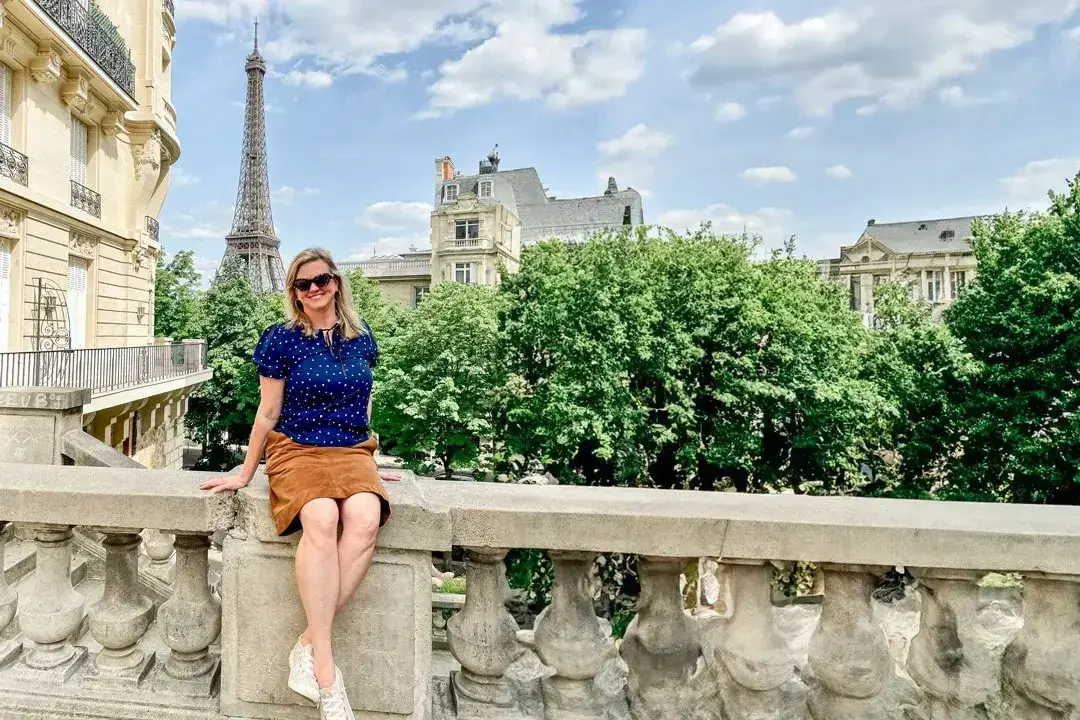Visiting Rome was truly one of the most magical trips I have ever taken. I was utterly amazed to be standing admist such ancient history as a living, breathing part of this city.
While I seemed to barely scratch the surface of all the things to do in Rome, I’ve compiled for you my tips, and some from my readers, about what to see and do in the Eternal City whether you’re visiting over a weekend, in the summer or over the winter holidays in November or Christmas in December.
A visit to Rome should be on everyone’s bucket list. While it’s not the most beautiful city in the world, it’s certainly one of the most vibrant and alive with an unparalleled history and incredible sites for Christians all over the world.
50 Magical Things to Do in Rome
Note: For many of the websites included here, you either need to find the “EN” button top right if it’s in Italian to switch to the English version (I’ve tried to link to those where I can) or right click (if you’re using Google Chrome) and select “Translate to English.”
Note: This post contains affiliate links, for which I may earn a commission if you make a purchase after clicking through. You never have to use my links, but I greatly appreciate it if you do!
Free Things to Do in Rome
1. Snap a Selfie at the Trevi Fountain

One of the most famous spots in Rome where every tourist wants to snap a pic (including me!) is the Trevi Fountain. The fountain, sculpted by Nicola Salvi and Guiseppe Pannini in 1762 shows Triton taming a chariot being pulled by sea horses.
Tradition holds that if you toss a coin in the fountain, you are guaranteed to return to Rome one day. I hope I get to return to Rome many more times! They say if you toss more than one coin it improves your chances of getting married.
I personally was surprised at how large this fountain is, yet how small the area around it actually is. It’s not a large open piazza or square like you see in many places throughout Rome and is jam-packed with people :).
Unusual Fact: Did you know that the water that flows through the fountain comes from an ancient Roman aqueduct?
2. See the Spanish Steps
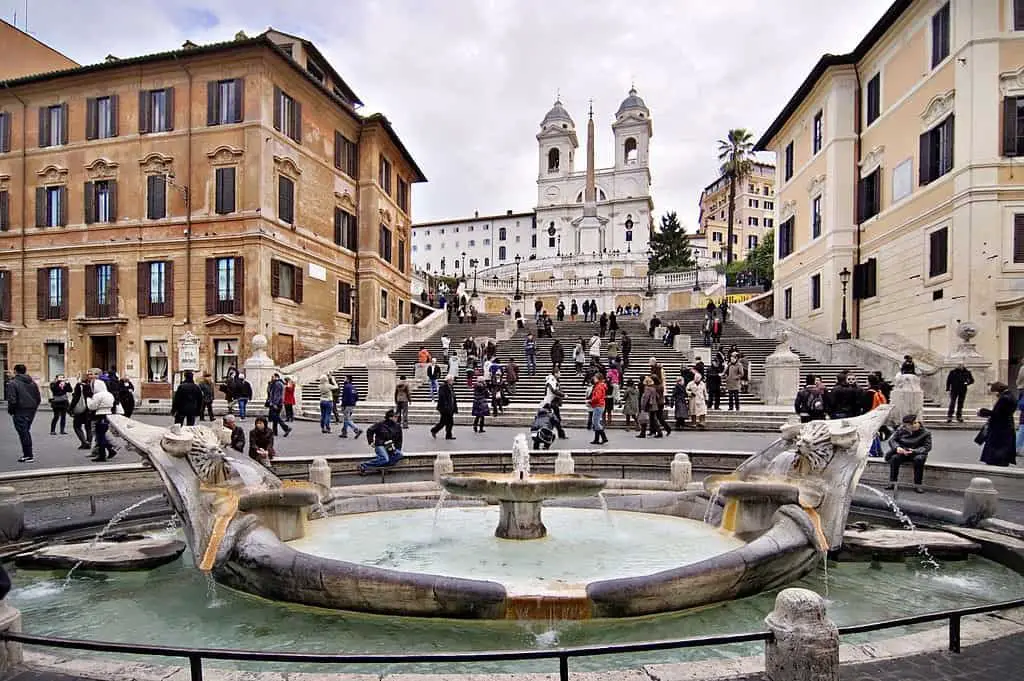
It is said that Rome is full of fountains, because as the air blows through the water during the hot summer months, it creates a much-needed cooling effect!

The Spanish Steps area is upscale with many luxury stores and hotels in the vicinity. While it used to be a popular place to sit, Rome has passed laws that no longer allow people to sit on the Spanish Steps. In fact, you’ll be fined $450 if caught!
TIP: A great time to see the Spanish Steps is in the spring when they are full of colorful azaleas.
3. Wander the Most Charming Area of Rome: Trastevere

Absolutely the most charming area of Rome, and in hindsight the area I wished we stayed, Trastevere, which was the former Jewish quarter, is a bit like the Left Bank of Paris but in Rome.
It’s utterly picturesque with many narrow cobblestone streets and corridors filled with trattorias, pizzerias, wine bars and lots of nightlife. You’ll also find some of the most beautiful piazzas, including Piazza Santa Maria in Trastevere, which houses the oldest Christian church in Rome, the Basilica of Santa Maria in Trastevere.
Originally completed in 340 A.D. though later rebuilt, the church’s interior features columns from the Roman Baths of Caracalla. Much of Christian Rome is literally rebuilt from among the ruins of ancient Rome.
4. Explore Piazza Navona and Other Main Rome Piazzas

Rome is filled with squares, or “piazzas,” which serve as the hub of Roman life. Piazza Navona is one of the more picturesque, and it’s built on the site of the Roman Emperor Domitian’s stadium, which stood in the first century A.D., and maintains the outline of the rectangular structure.
There you will find three fountains, including Bernini’s Fountain of the Four Rivers, where four figures represent the great rivers of four continents, and the Church of Saint’Agnese in Agone. Street artists will also happily sketch your portrait for a fee.
5. Put Your Hand in the Mouth of Truth
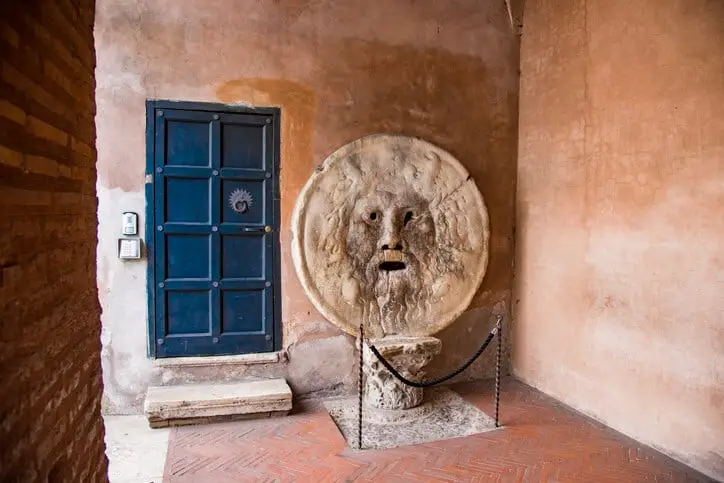
We noticed this funny site as we rode throughout Rome on buses and taxis. Wherever we were going, it seemed we always passed by!
Our driver for our trip down to the Amalfi Coast filled us in that legend has it that the sculpture (which is actually thought to be a drain cover) bites off the hand of anyone who puts their hand inside the mouth and who isn’t telling the truth :). We didn’t try it out… but seems like this would be a fun activity if you’re traveling with kids :).
You’ll find the Mouth of Truth in the portico of the Basilica of Santa Maria in Cosemedin where it draws thousands of visitors every year.
6. Stand in Front of the Arch of Constantine
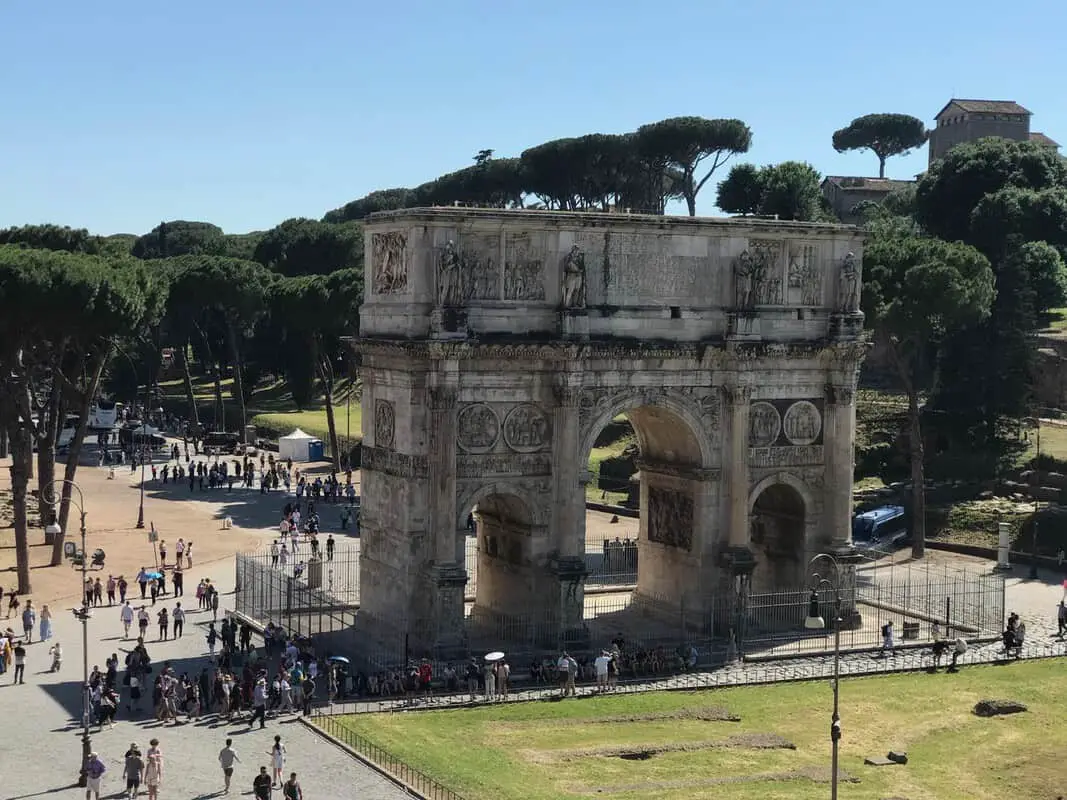
There are three “triumphal arches” in Rome, which means they celebrate a victory in battle. The Arch of Constantine, built in 315 A.D., stands as the largest and commemorates the victory of Constantine over Maxentius.
The arch is composed of architectural elements removed from more ancient Roman structures.

You’ll find it in the shadow of the Colosseum and you can visit both together. Its location was once along the processional route for ancient Rome.
7. Walk the Via Giulia

Described by many as the “prettiest street in Rome,” the Via Giulia is a quiet cobblestone street offset from the main thoroughfares perfect for an evening stroll.
You’ll also find the Hotel Indigo St. George Rome, where we stayed for part of our trip to Rome. Don’t miss the rooftop bar for outstanding views of Rome!
According to the New York Times, the street was built in the 16th century by Pope Julius II. You’ll find an ivy-covered arch designed by Michaelangelo himself, as well as numerous churches and fancy palazzi.
8. Take an Evening Stroll Like the Locals

If you want to feel like a local, take an evening stroll, a “passeggiata” in Italian. It’s a cultural tradition, and I suppose it helps burn off all the pizza, wine and other delicious Italian food you enjoy each day :).
In Rome, it’s fun to walk from palazzo to palazzo or from fountain to fountain. Though the Via del Corso is one of the most popular routes, it’s full of brand name stores you can find elsewhere in the world.
[Want to learn Italian? Here’s how to do it quickly in 5 steps]
9. See the Circus Maximus

Today, however, the Circus Maximus is not much to see. All that remains is the outline of the oblong stadium, as people walk their dogs over this green field of grass.
An amazing option that lets you step into what the Circus would have been like 2,000+ years ago is the Circo Maximo Experience. Using “augmented” and virtual reality headsets, you can walk the current grounds and have overlapped how it would have appeared, including seeing the Arch of Titus and a chariot race.
It is a 40-minute walk that includes eight stops. Tickets are 12 Euro per person, which you can buy online.
10. Climb the Popstairs

At three different sites in Rome, you can climb the “popstairs.” These are steps that have a mural painted on them. They include:
- Actress Ingrid Bergman at Via Fiamignano, 7
- Actress Michèle Mercier at Via Ronciglione, 20/a
- Actress Elena Sofia Ricci at Via Ugo Bassi, 16
Top Attractions in Rome
11. The Colosseum

Of course, you cannot leave Rome without a visit to its magnificent Colosseum. I recommend taking a tour of the Colosseum with the Roman Guy or another reputable tour company, as they get you fast access to areas like the “underground” and provide so much fascinating information!
The Colosseum, whose construction began in 72 A.D., was of course the site of the ancient Roman “games” where gladiators battled and many men and women died fighting animals and gladiators for crimes against the state.
Though it is largely held that Christians were martyred here for their faith, I was told otherwise by multiple sources in Rome. Christians DID die here, but for crimes against the state, not for being a Christian.
It was at the Circus of Nero on the current site of St. Peter’s Cathedral and St. Peter’s Square where many Christians were martyred for their faith, including Jesus’ apostle and first pope, Peter.
FASCINATING FACT: The structure, which only stands in part today, was originally encased inside and out in marble. Today, that marble covers the floors of the Vatican Museums. When Rome fell, much of the highly valuable marble on temples and buildings was removed and used in other structures.
How to See the Colosseum
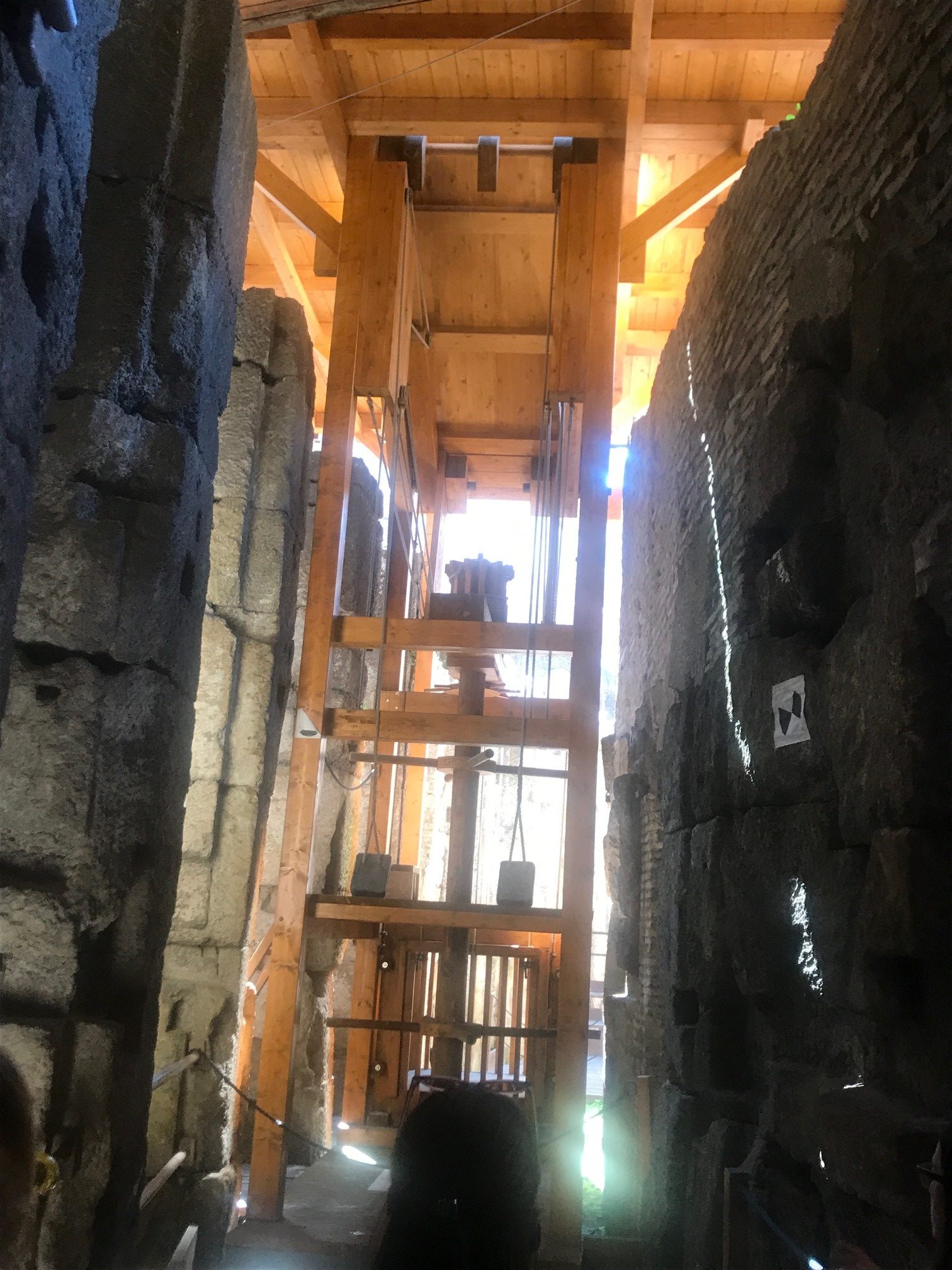
We took the Roman Guy’s Colosseum Underground tour, which allows you to go “underground” and walk the same tunnels that these ancients walked before going to their death, as well as see the lifts they used to put the animals up onto the colosseum floor to create a theatrical “surprise.”

If you don’t take a guided tour, you should buy a ticket in advance here or purchase a Roma Pass, which gives you entry to the Colosseum and many other attractions, and allows you to skip the lines.
Additionally, the Rome subway has a stop right at the Colosseum for easy access.
12. The Roman Forum and Palatine Hill

Aside from the Colosseum, the Roman Forum is probably the most famous site in Rome. It is the ruins of ancient Rome, dating from the reign of Julius Caesar in 54 B.C. and is a series of forums built by various emperors that served as the hub of ancient Roman life for more than a millennium.
The largest and most impressive in size is the Forum of Augustus, which is a temple to multiple Roman gods. You’ll also see the Temple of Julius Caesar, the Roman Senate building and more. Julius Caesar was one of the emperors who had a large part in building the forum and there is a Forum of Caesar area (46 BC) of his works.

I highly recommend exploring this area on a tour, so you can get a full understanding of what you’re seeing. We took the Roman Guy’s Colosseum Underground with Roman Forum and Palatine Hill tour, which was fantastic, though it’s a long day with a lot of walking!

The Palatine Hill is even older and is said to be where Romulus and Remus founded Rome in 753 B.C. and you can walk among the ruins of even older buildings than the forum, even viewing some remains of floor tiles. This was where first and second century BC wealthy Romans resided.
There is also a spectacular view of the Roman Forum from on this hill.
You can buy a Forum Pass that grants you access to the Roman Forum, Palatine Hill and the Imperial Forum (which actually crosses over a busy road) for one ticket that costs 16 Euro per person.
13. The Pantheon

When in Rome, you absolutely CANNOT miss the Pantheon, which is FREE to enter. Now a Catholic Church where you can attend mass, it was once a Roman temple dedicated to the gods built between 118 and 125 A.D.
It features an “oculus” where light enters at the top, which lights the whole structure, and is the only ancient Roman building that has remained largely intact.

The tombs of many of Italy’s kings are here, and it is also the burial place of the great artist Raphael (he requested to be buried here because it so inspired him), as well as many Christian martyrs, whose remains were moved here in the 600s.
14. Sistine Chapel

When in Rome, you must visit Vatican City and see Michelangelo’s magnificent Sistine Chapel where Michaelangelo famously painted the ceiling in the early 1500s. The ceiling depicts the Book of Genesis and includes the iconic image of God reaching his finger out to touch Adam.
This chapel is where the Cardinals convene to elect a new Pope and is actually a part of the Vatican Museums. You can purchase a base ticket for both the museums and the Sistine Chapel with no audio or guided tour for 17 Euro, or on the last Sunday of the month, admission is free to the Vatican Museums. Expect HUGE crowds if you decide to visit on this day!
15. Baths of Caracalla

We found the the “terme di Caracalla” (you’ll need to know the Italian version if you take a taxi!) to be utterly fascinating. These are the ruins of the popular ancient Roman baths where Romans would come together to socialize.
The Baths of Caracalla were built in 216 A.D. and could hold between 6,000 and 8,000 people daily.
Amazingly, you can still see a portion of the frescoes that lined the floor under these massive pools, and you may even pass a restorer hard at work on keeping them intact.
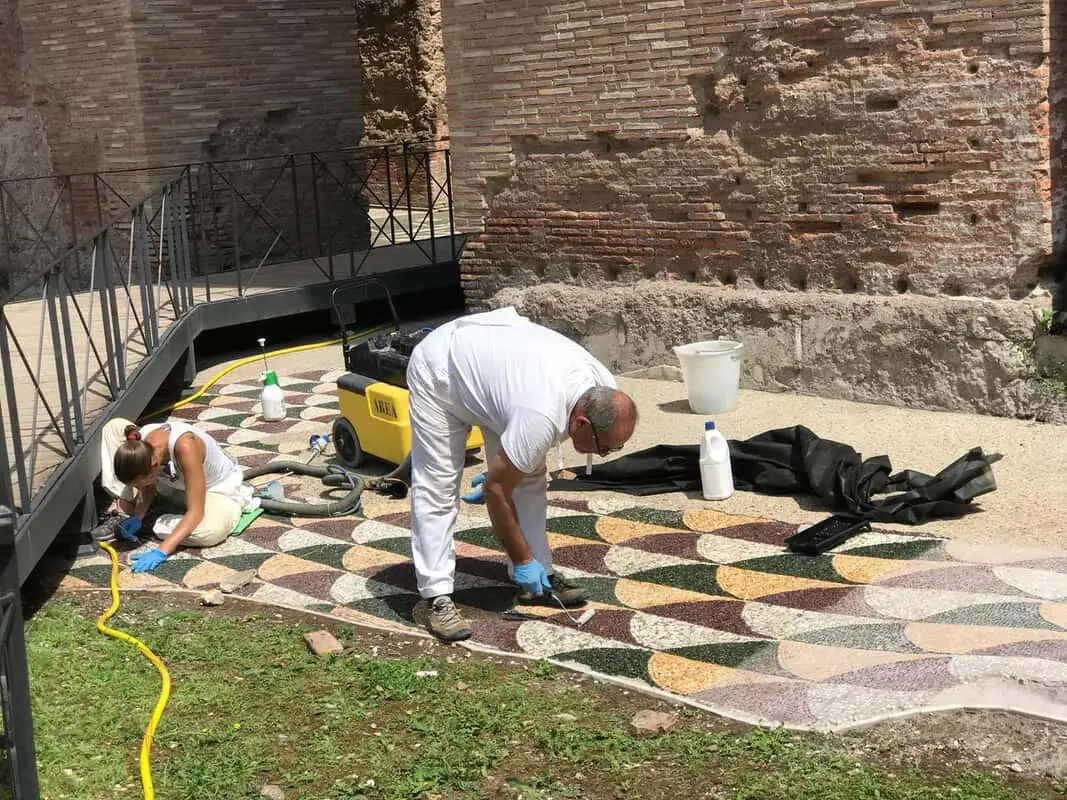
The baths are open daily and tickets are 8 Euro.
16. The Catacombs of Domitilla

There are several catacombs sites in Rome, but we visited the Catacombs of Domitilla with tour company The Roman Guy. This was my favorite guide throughout the trip, as he was a college professor and incredibly knowledgeable (ideal if you’re a history geek :)). I highly recommend this tour, which is combined with a visit to the Basilica of San Clemente.
The catacombs are ancient sites where Christians, especially, were buried due to a lack of ground space. This area is a vast complex (it’s one of the two largest in Rome; this one spreads over 17 kilometers!) that would be easy to get lost in without a guide!
Most of the bones that were once here have since been removed or ground to dust.
Inside is a 4th century basilica (though the complex dates to the 2nd century A.D.) over the tombs of Christian martyrs Nereus and Achilleus, who were likely executed for their faith by the Emperor Diocletian.
Throughout the catacombs, you’ll also see many ancient Christian frescoes, depicting scenes from the Bible, Jesus and his 12 apostles.
INSIDE TIP: Keep in mind it’s cool in these areas, so best to bring along a scarf to cover up if needed.
17. Walk the Ancient Appian Way
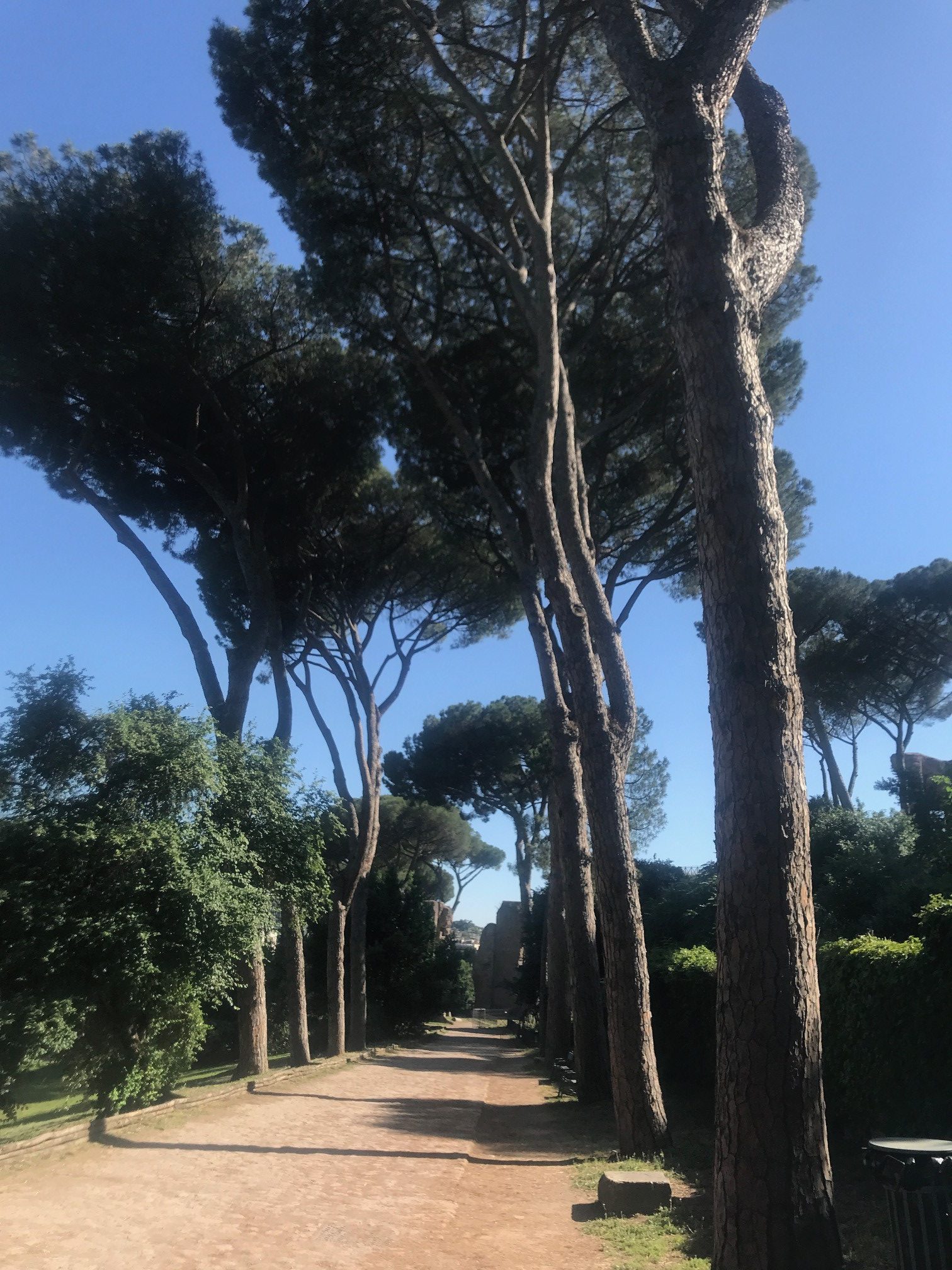
All roads lead to Rome, right? Romans were known for building an elaborate road system, and the Roman Road, also known as the Appian Way, or the Via Appia, was designed in 312 B.C. to connect Rome to Capua and eventually Brindisi, which connected Rome to Greece, the East and Egypt.
It was repaved in 189 B.C., some of the stones of which you can still see today and literally walk the road trod by everyone from Constantine to Napoleon.
Many of the Christian catacombs sit along the road, as well, and so it eventually became a popular route for pilgrimage.
18. Castel Sant’Angelo

Castel Sant’Angelo, an interesting, but oft-overlooked structure due to the many sites to see in Rome, is very visible on the Vatican side of the Tiber River. It was originally constructed as a tomb for the Roman Emperor Hadrian around the year 123 AD and served that purpose until around 400. Later, it became a fortified safe haven for popes.
It is now a museum with a collection of items related to the Italian army. So you may not be interested in that so much as the building itself…
Interestingly, there is an elevated corridor that connects to the Vatican, which provided the popes an escape route from the Vatican. The passage was used multiple times for this purpose, including during the sack of Rome in the 1500s and when France overran Rome in the late 1400s.
The corridor is open to the public at certain times of the year, and this could make a great activity in case of rain since it’s indoors.
19. The Victorian or “Wedding Cake” Monument
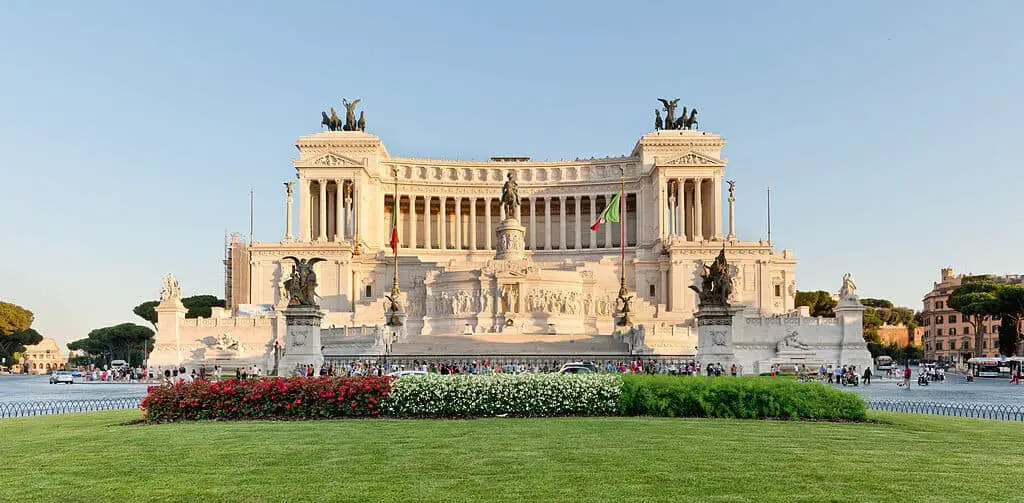
Il Vittoriano, or the Victorian in English, was built as a monument in the late 1800s to honor the first King of Italy, but today it has become a symbol of the city and of Italy. The body of the unknown soldier is also buried here, and it now hosts major art exhibitions.
This is one of the craziest areas of the city to drive, so if you are in a taxi in this area either close your eyes or enjoy the thrill ride!
20. Take a Big Bus Tour of Rome

One of our favorite things to do in a new city is to take a Big Bus Tour. We find Big Bus to be a reputable, reliable company that gives you a great overview of a city and its top attractions, while also allowing you to hop off and hop back on as much as you’d like to explore further.
TIP: Their buses nearly always seem to arrive about every 30 minutes at each stop, and though the best seats may be taken when you “hop” back on, usually after a stop or two, they open back up again as people get off.
We like sitting on the top, as it gives you a different and better perspective of a city, especially its architecture. Overall, we find it helps us orient ourselves to a new city and discover where we’d like to spend more time in the coming days.
The Big Bus Tour of Rome includes two daytime routes and a nighttime tour, though it has a recorded commentary and not a live guide as some cities do.
The Red Route goes by:
- The main Rome Termini train station (this is the easiest spot to get on, though the train station is a bit crazy, so beware!)
- The Basilica of St. Mary Major
- The Colosseum
- The Circus Maximus
- Piazza Venezia (where you can access the Roman Forum, the Pantheon, Palatine Hill, Piazza Navona, Campo de Fiori and more)
- The Vatican
- The Spanish Steps
- Piazza Barberini (access to the Villa Borghese)
The Purple Route goes by the following and allows you to take the ancient Via Appia (Appian Way) and skip the Vatican:
- The main Rome Termini train station (this is the easiest spot to get on, though the train station is a bit crazy, so beware!)
- The Basilica of St. Mary Major
- The Colosseum
- Porta San Sebastiano
- Catacombs & Church of San Sebastiano
- Caffarella Park
- Domine Quo Vadis
- Baths of Caracalla
- Circus Maximus
- Piazza Venezia (where you can access the Roman Forum, the Pantheon, Palatine Hill, Piazza Navona, Campo de Fiori and more)
21. Hadrian’s Villa
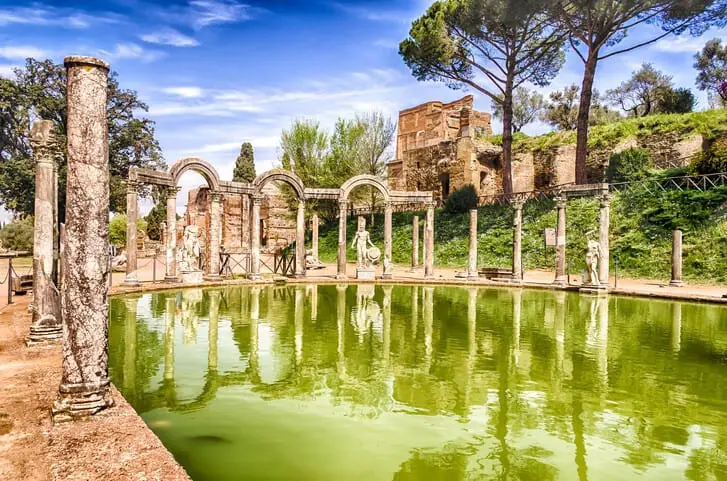
For an example of how an ancient Roman emperor lived, tour Hadrian’s Villa, the largest such residence owned by an emperor and 1 square kilometer in size.
About 25 kilometers from Rome in the town of Tivoli, the villa includes palaces, baths, temples and a theatre and is an outstanding example of ancient Roman architecture.
Rome Museums & Gardens
TIP: Rome state museums are all FREE on the first Sunday of the month October through March. Paris has a similar deal!
TIP: Purchase an MIC card for entrance to ALL state museums for 5 Euro (+ 1 Euro for online processing) good for 1 year.
22. Explore the Capitoline Museum and Hill

The Capitoline Hill is the smallest of the seven hills of Rome (including the Palatine Hill) and once served as the ancient Capitol. There are many ruins that you can see there today, including the Tabularium (the public Roman archive) and Temple of Juno Moneta.
The piazza there was designed by Michelangelo and features many palaces, or palazzi.
The museum on the site dates to 1471 and features ancient bronze sculptures, as well as frescoes by Guercino and Caravaggio.
23. Get Lost in the Vatican Museums

The Vatican Museums are a vast and fascinating complex of the collections of the Vatican and of the popes over the last 2,000 years. This includes vast collections of ancient artwork, including Roman, Etruscan and early Christian, works from around the world and even modern artwork.
Also inside are the Niccoline Chapel with paintings from famous fresco artist Fra Angelico, the Borgia Apartment, which is the residence of a 15th century pope, and paintings by Raphael in the Loggia.
Great works at these museums include:
- Raphael’s Transfiguration
- Raphael’s The School of Athens
- Laocoön sculpture
- The Gallery of Maps with painted maps of Italy on its walls (the ceiling is magnificent too!)
FASCINATING FACT: The marble that lines the floor of the Vatican Museums once covered the exterior of the Colosseum.
24. Marvel at the Vatican Gardens

An absolutely lovely place to see are the Vatican Gardens where many a pope, since 1279, contemplated their most important decisions.
You can book a guided tour of the Gardens (you can’t wander alone) together with an open tour of the Vatican Museums and Sistine Chapel, starting at 33 Euro per person.

We opted for a tour with the Roman Guy that included the Vatican Museums, Vatican Gardens, Sistine Chapel and a train trip to the pope’s summer residence, Castel Gandalfo (see more below), with lunch included for 106 Euro per person.
INSIDE TIP: Some tours and tickets, like the Roman Guy, allow you to enter the Vatican Museums 45 minutes ahead of the general public, which is a GOOD idea, as they can be filled to capacity!
25. Enjoy Nature at the Borghese Gardens, Museum & Villa Borghese

This area, which was owned by the Borghese family since the 1500s but is now owned by the Italian State, sits in the heart of Rome.
It features nearly 200 acres of green space with ponds, fountains and gardens, as well as the Borghese Gallery housed in the villa with artwork by Bernini, Titian, Canova, Raphael and Caravaggio.
Religious Things to Do in Rome
26. St. Peter’s Basilica

Arguably the most famous church in the world, St. Peter’s Basilica was originally completed in 326 AD by the order of the Roman Emperor Constantine, who legalized Christianity. The church was built over the spot of the apostle Peter and first Pope’s tomb where in the last century, the Catholic Church believes it has uncovered Peter’s remains beneath the church, which you can now see if you go down the stairs inside the church.
It is also the site of Nero’s Circus, where many games took place and Christians were killed. This is also where Peter was martyred hanging upside down on a cross, so he did not die the same death as Jesus Christ.

The church was rebuilt during the Renaissance with the help of artists Raphael and Michelangelo (who helped design its magnificent dome, and, of course, painted the ceiling of the Sistine Chapel).
Inside, you will find the tomb of St. John Paul II and Pope Paul VI, the tombs of many other popes, as well as
Michelangelo’s famous Pieta sculpture of Mary holding the dead body of Jesus, her son.

INSIDE TIP: Inside the Vatican Museums is an exact replica of the sculpture if you’d like a closer look rather that from behind a sea of heads inside the church :).
INSIDE TIP: Keep in mind there are very often long lines to get into St. Peter’s, as there is an in-depth security check. You can bypass the lines with a tour with the Roman Guy or by purchasing an OMNIA Pass.
About the OMNIA Pass
This pass lets you “skip the line” at many attractions, grants free entry to top attractions like the Colosseum, Roman Forum and Palatine Hill and gives you free 72-hour public transportation in Rome. Note: Their hop-on, hop-off bus tour is NOT great (we NEVER saw one), and I’d recommend a Big Bus Tour of Rome instead.
The cost of the pass is 113 Euro per adult or 80 Euro per child.
More St. Peter’s Tips
- You can also climb to the top of the dome for amazing Rome views.
- Be sure to wear something covering your shoulders and knees or carry a scarf to cover your shoulders in order to enter the church.
27. St. Peter’s Square

St. Peter’s Square, or Piazza San Pietro in Italian, is in the shape of a key hole, as Peter is known as the “keeper of the keys” of Jesus’ church, and is often depicted holding a set of keys.
The Egyptian obelisk that stands in the square was brought from Egypt during the time of Caligula. On top of the obelisk there is a relic of Jesus’ cross.
The Four Main Basilicas of Rome
There are four major Catholic Basilicas in Rome — all worth a visit! They include:
- St. Peter (described above)
- St. John Lateran
- St. Mary Major
- St. Paul Outside the Walls
28. St. John Lateran
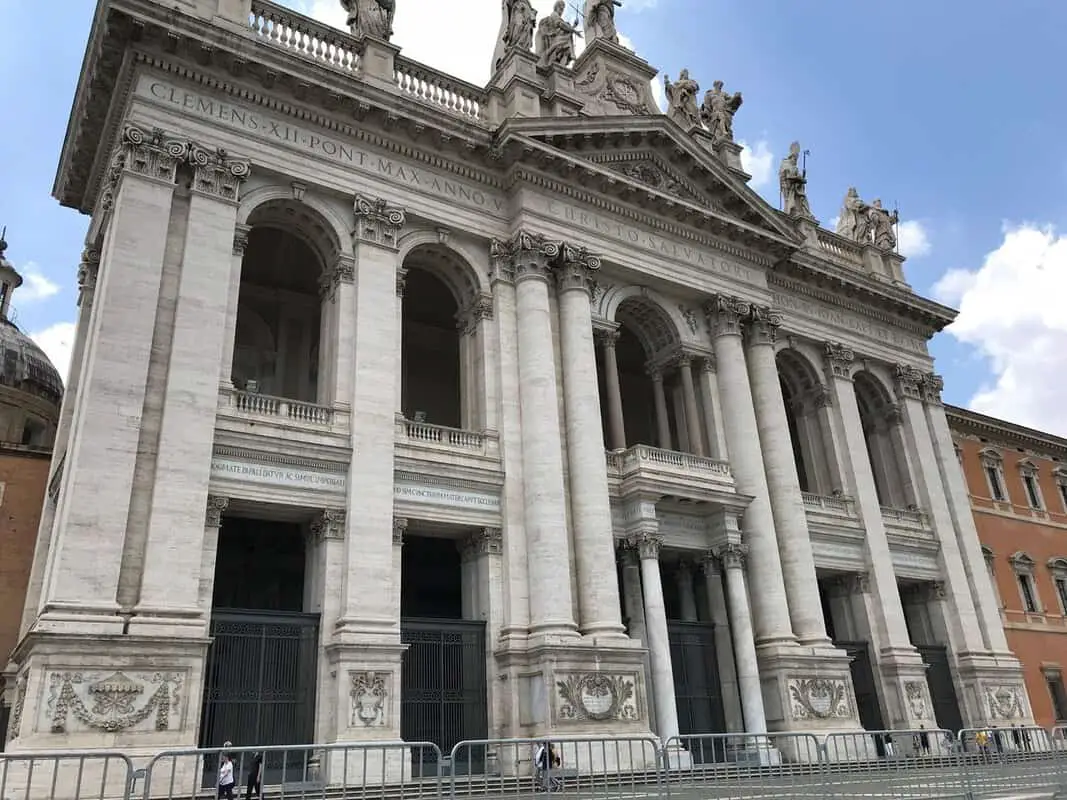
St. John Lateran is actually the Pope’s church as Bishop of Rome, not St. Peter, and the city’s cathedral. It served as the seat of the Papacy from the 4th century to the 14th century BC.
It is the oldest church in the Western world commissioned in the 300s AD by the Roman Emperor Constantine, who legalized Christianity, and is dedicated to John the Baptist and John, the evangelist (the apostle of Jesus and one of the four writers of the Gospels). The current structure was built in 1646.
FASCINATING FACT: The massive (and I mean MASSIVE) bronze doors on the front exterior of the Basilica were actually the doors of the ancient Roman Curia.

A reliquary inside is said to hold the heads of Saints Peter and Paul, and The Altar of the Holy Sacrament is said to contain a cedar table that was used by Jesus at the Last Supper.
29. St. Mary Major

For me, St. Mary Major was the most special church we visited. I felt a bit intimated at St. Peter due to all the great people who have walked its floors (they probably walked those of St. Mary Major too, but it just was not as readily apparent).
It is a calm and peaceful place where you can see what tradition holds is a relic of the wood from the manger where the Baby Jesus was laid. Note the cradle, or crib, that you see there is a reconstruction of the crib of Jesus dating to 432, not Jesus’ actual crib.
This is the largest church in Rome dedicated to Mary, and has the highest bell tower in the city. It is said to have been built on the site of a miraculous snowfall in Rome.
30. St. Paul Outside the Walls
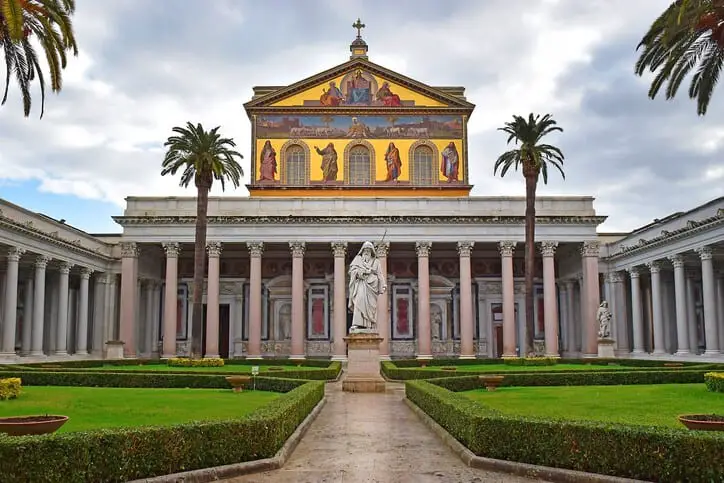
The Emperor Constantine commissioned the church of St. Paul Outside the Walls to be built over the site of St. Paul’s tomb. Paul was martyred by beheading by the Roman Emperor Nero. His body now lies entombed under the altar with a marble tombstone denoting the “Apostle Paul, Martyr,” though it is said that his head is kept at St. John Lateran.
The church, built in 324 AD originally but reconstructed in the early 1800s, sits outside the Aurelian Walls, which is why it is so named.
31. Attend the Pope’s Wednesday Papal Audience/Sunday Morning

If Pope Francis is in Rome when you visit, you can see him (albeit likely from a distance :)) in several ways.
1. He leads the Angelus prayer on Sundays at Noon in St. Peter’s Square where he will appear from a window there. He gives a short homily followed by a prayer and papal blessing (bring anything you’d like blessed!).
2. Or you can attend the “papal audience” on Wednesdays at 9:30 a.m. in St. Peter’s Square. You can get free tickets to the audience (download the form from this link and submit as instructed), which grants you a seat that is slightly closer, but you can also just show up without a seat and stand in St. Peter’s Square like I did. Large screens broadcasts Pope Francis and you can still see him, but again, from far away. It’s much less hassle than getting into and out of the seats for the official “audience.”
3. Or you can attend a mass presided over by Pope Francis. You’ll need to check the schedule here to see when he is leading mass during your visit (if he is) and then download the form HERE to request tickets. You will need tickets to this.
Here is the Pope’s schedule for 2019.
32. Climb the Holy Stairs on Your Knees

Tradition holds that these stairs, known as the “Scala Sancta” in Italian, are the ones climbed by Jesus to reach the praetorium of Pontius Pilate, which would ultimately lead to his death on the cross.
It is believed that St. Helen, the Roman Emperor Constantine’s mother, brought the stairs to Rome from the Holy Land in the 300s AD.
Located directly across from St. John Lateran (more info above), these two stops are great to pair together. Pilgrims are invited to not only see these 28 marble stairs but walk up them on their knees as a sign of penance, honoring Jesus’ crucifixion and death. There is no cost to do either.
33. See Relics of the Saints and Jesus
There are relics of saints and of Jesus himself spread throughout Rome at nearly every Catholic Church you enter. I happened upon a church where I went to mass just down from our hotel and was surprised to find Mary Magdalene’s foot!
Now much of these relics, which are honored (not worshipped) by Catholics, are held to be what they are by tradition passed down, as there’s no true way to know for sure.
St. Mary Major has what is said to be a relic of wood from Jesus’ cradle, you can visit the body of St. Cecilia in Trastevere, the skull of St. Agnes at Sant’Agnese in Agone in the Piazza Navona and even the relics of St. Peter underneath St. Peter’s Basilica (simply walk down the stairs inside the church and wander among the tombs of the popes where you will also find St. Peter’s relics).
34. See the Swiss Guard

These colorful guards of the Pope, who date back to the 1500s, are a fun and iconic site at the Vatican. The Swiss Guard serve as “personal escorts” to the Pope, and their dress is in the colors of the Medici family from the days of the Renaissance.
According to Brittanica.com, members of the guard must be unmarried Roman Catholic males who are Swiss citizens (apparently, the Swiss have long been known to have the best soldiers in the world) between the ages of 19 and 30, and they must be at least 5 feet 8 inches tall.
The guard is trained in modern weaponry and anti-terrorism techniques, and they have defended the Pope during the sack of Rome 1527, during World War II and when Pope John Paul II was shot, though not killed, in 1981.
35. Mail a Letter From the Vatican Post Office

The Vatican is its own country, after all. It even has its own license plates and, of course, its own postal system. A fun and unique souvenir can be to mail yourself, friends or family a postcard or letter that is postmarked from the Vatican!

According to the New York Times, more mail is sent each year (per resident) from the postal code for the Vatican (00120) than from anywhere else in the world. Amazing.
The article also quotes a woman from a United Nations agency as saying it’s one of the best postal systems in the world.
Food in Rome
36. Find the Perfect Rome Restaurants

It can be tough to find non-touristy, local-favorite restaurants in Rome, but that’s definitely where you want to go to find the best food.
Skip any place that has the photos of the food on its menu or has someone out in the street trying to get customers. Those are usually tourist traps.
“The best places were typically located off side streets, and we found them with the help of apps that rate restaurants,” said Danica L., a Go to Travel Gal reader, of her trip to Rome. “Finding a good place to eat became part of the adventure, and my husband set out on a quest to find the best lasagna (his all time favorite dish) in Rome. His top pick was Ai Tre Scalini located in the central district in Rome.”
A local favorite, that unfortunately EVERYONE seems to know about, is Da Enzo, a tiny, little hole-in-the-wall of a place in Trastevere that has hordes of people waiting for one of the very few tables inside. We tried to go there twice in early June, but the wait was more than an hour, even arriving when they first open around 7:30 p.m. They don’t take reservations, unfortunately, so good luck!
Here are some other top Rome restaurants recommended by past visitors:
- Grazia e Graziella in Trastevere. Go to Travel Gal team member Stephanie A. recommends the eggplant, zucchini and pepper pizza.
- Pane e Salame – Stephanie A. also recommends this restaurant near the Trevi Fountain, which she says has cheap sandwiches. “It’s one of the few places in Italy with poultry on the menu,” says Stephanie.
- La Vittoria near the Vatican
37. Eat Pizza al Taglio

Rome’s pizza is AMAZING. Find a hole-in-the-wall pizzeria and eat it for breakfast, lunch and dinner. It’s cheap, filling and so yummy!
In Rome, you’ll most often find pizza cooked in a rectangular pan and cut (taglio) to the size you want.
Order “un etto” for a snack size, “due etti” for a light meal or show the size you want by using your hands.
38. Enjoy Roman Specialties

Anywhere in Italy, food is pretty much INCREDIBLE. I would happily venture to Italy every year just to eat!
Rome offers several specialty dishes, including cacio e pepe, which the Musement blog recommends eating at the restaurant Flavio al Velavevodetto. It’s a simple dish of pasta with pecorino Romano cheese with black pepper.
Another dish we ate often was pasta carbonara, which includes eggs, pancetta or bacon, and pecorino Romano cheese.
AND don’t miss the pizza, which was my favorite dish in Rome (see entry above).
39. Drink Limoncello!

One of my favorite drinks in Italy (besides the wine!) is limoncello — delicioso! This after-dinner liqueur is supposed to help you digest your food.
The best version is made in nearby Sorrento and along the Amalfi Coast where they are famous for their lemons, but many restaurants make their own in-house limoncello that is just as yummy.
Beware — it is strong and a shot will do ya! — but it’s SO good.
40. Drink Wine & Visit a Wine Bar

When in Italy, drink much wine! I am partial to the Chianti, Brunello and Montepulciano varieties from the Tuscan region not too far away.
We find “un mezzo” (or half a liter) to be just about right for two people, and typically the table wine or “house” wine is plenty delicious.
TIP: If you want to try many different types of Italian wine, visit an “enoteca” (there are many in Trastevere). Try Vin Allegro in Trastevere.
41. Snack on Gelato

Also when in Italy, eat much gelato.
We learned that you should not order just one flavor of gelato, but ideally three and at least two, as the flavors are designed to complement each other. You’ll look like such a “tourist” if you order just one :).
Go to Travel Gal team member Stephanie says Frigidarium has the BEST gelato in Italy. “For 2 euros, they give you a small cone with two large scoops and the choice of having it dipped in white/milk chocolate or with whipped cream,” she says.
We headed to a spot called Old Bridge Gelateria, just outside the Vatican Museums, where we’d heard Catholic seminarians studying for the priesthood frequent and declare IT to be the best gelato in town. The sets of three flavors are already recommended for you, and we give it two thumbs up.
42. Take a Pasta-Making Class

Reader Danica L. recommends taking a pasta-making class with Walks of Italy.
“We joined a group of nine other tourists at an apartment in the heart of Rome where two very patient and friendly chefs taught us to make our own pasta, and then served it to us in a delicious three course meal,” she says. “It was a fun experience and one of our favorite nights on the trip.”
Danica says they continue making their own pasta from what they learned to this day!
43. Shop the Campo de Fiori Market

For more of a local feel, head to Campo de Fiori, a piazza, which hosts a daily food market, where Romans come to load up on fresh fruit and veggies.
There’s also an AMAZING pizza place where you walk in and tell them how large of a “cut” you want of the rectangular shaped pizza.
This piazza once served as the spot for public executions. By night, it’s a hot spot with bars and restaurants.
44. Enjoy Rooftop Dining or Drinks
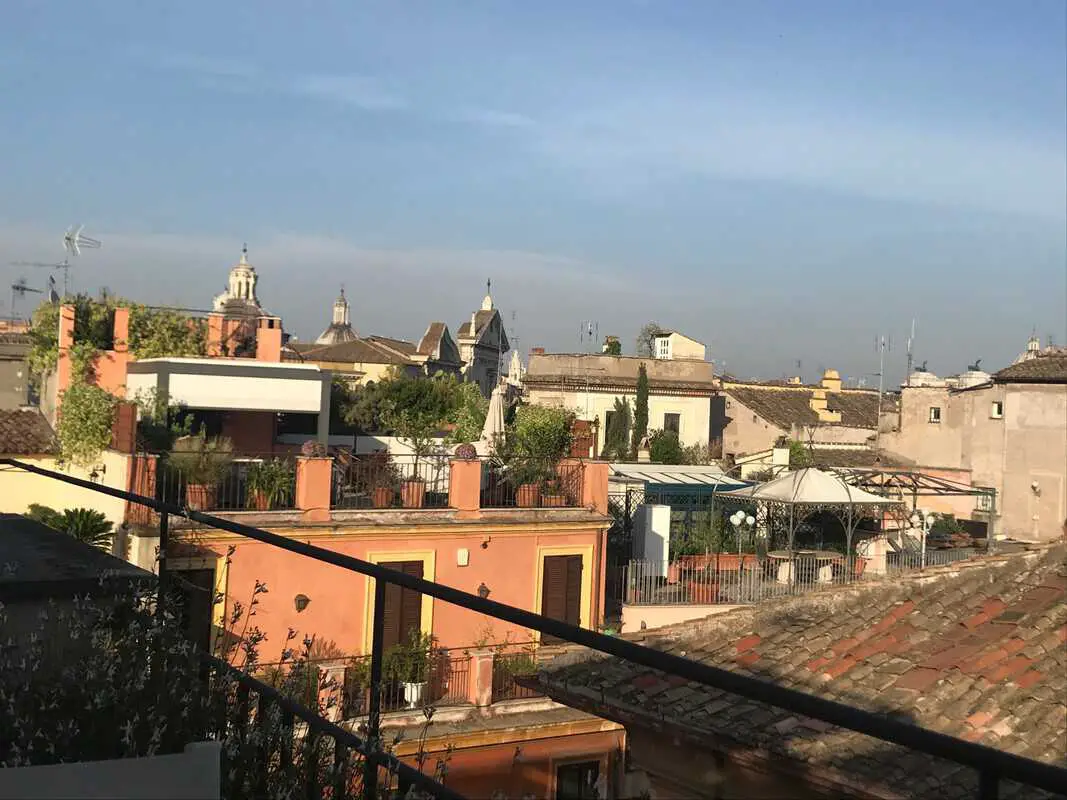
There are many spots in Rome from hotels to restaurants to vacation rentals and homes offering rooftop views of the city.
Here are some Rome restaurants with rooftop views to consider:
- Terraza Borromeni overlooking Piazza Navona
- Ristorante Roof Garden Hotel Forum, overlooking the Forum (they do take reservations); try the Aperol Spritz
- Harry’s Bar Hotel & Restaurant next to the Trevi Fountain
Rome Hotels & Accommodations
You’ve got several options when it come to where to stay in Rome. Choose a small boutique hotel, a larger chain hotel or a vacation rental with a company like HomeAway, which we’ve used frequently in the past, or Airbnb.
45. Stay in a HomeAway
While staying in a hotel is definitely an option in Rome, as there are many great hotels, it can also be fun to stay in a Rome vacation rental through a company like HomeAway.
We find vacation rentals help us feel more like locals, as often you’re staying in a real apartment or home, and also usually give you access to a kitchen and laundry (beware: European washers and dryers are a different breed!!), as well as one or two separate bedrooms.
Here are my tips for things you should know when booking a HomeAway.
There are some AMAZING vacation rentals in Rome, especially in charming Trastevere. Here are some options from HomeAway:
Trastevere Beamed Ceiling Apartment With Balcony

Super charming apartment with space for up to four people in Trastevere with balcony and beamed ceilings for $140/night.
Apartment Near Vatican With Balcony

This apartment close to the Vatican sleeps up to six and has a kitchenette, two bedrooms and a small balcony for $180/night.
46. Stay at Hotel Indigo Rome – St. George

For the first half of our trip to Rome, we stayed at the lovely and charming Hotel Indigo Rome St. George located on beautiful Via Giulia. Hotel Indigo is one of my favorite hotel chains, as it has the benefits of a larger chain (owned by InterContinental Hotels Group), but the feel of a boutique hotel and is always very localized to the city.
We also loved the Hotel Indigo Paris Opera in Paris!
This hotel, which starts at 50,000 IHG points per night or ~194 EURO/night, has small but modern rooms (you won’t be spending much time in your room anyway, except to sleep!) and lots of amenities we enjoyed.

The first thing I did after a quick nap from an overnight flight was head upstairs to their rooftop bar to enjoy a glass of wine while overlooking the city’s rooftops. Glorious!

We also enjoyed the property’s daily breakfast buffet in their courtyard with plenty of American options (which can be hard to find in Europe!). AND, probably my favorite thing is that they give you a complimentary smartphone in your room, which you can take with you and use to navigate around the city without using data on your own smartphone.
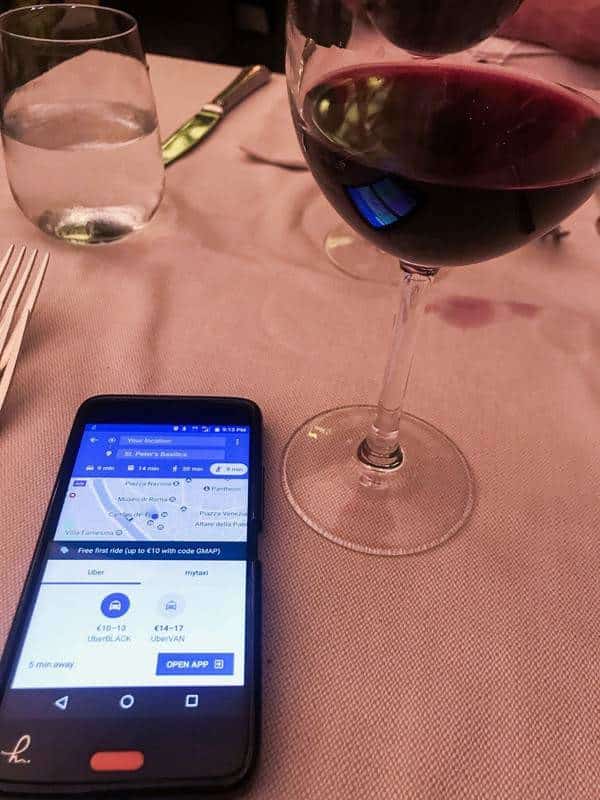
The location is ideal, an easy walk to Trastevere, Piazza Navonna and bus stops to get you elsewhere (we found the buses easy to navigate using Google Maps), though it’s not close to a subway stop.

I would absolutely stay here again!
47. Stay at the Hotel Aleph Rome, Curio Collection

A part of Hilton’s higher end Curio Collection, the Aleph Rome Hotel is an elegant upscale hotel near the Spanish Steps, which is close to shopping and other tourist attractions like the Trevi Fountain and Villa Borghese. It’s located in a beautiful building constructed in the 1930s.
They were kind enough to grant us a spacious suite, which I could easily have moved into!
We enjoyed their breakfast buffet, which is more European, less American-style, and the hotel also has a rooftop pool, rooftop bar, the Sky Blu restaurant, a gym and spa.
Misc Things to Do in Rome
48. Take an Electric Bike Tour
An electric bike tour is TONS of fun, as it allows you to enjoy all the benefits of seeing a city by bike in the open air, smelling the smells, stopping to chat with locals and no windows separating you from the beauty around you, while not wearing yourself out either!
Electric bikes add more “power” to your pedaling, helping you better climb hills and ride further without tiring out.
The Roman Guy offers a half-day Rome electric bike tour with a maximum of 10 people to see many of Rome’s top sites, including the Colosseum, Trastevere, the Pantheon, the Trevi Fountain and the Spanish Steps.
49. Ride in a Taxi

Let me tell you, a ride in a taxi in Rome is not for the faint of heart (about 10X worse than a New York City taxi ride!) but it is safe, at least in our experience.
We had heard talk of being swindled and ripped off by drivers, but we never found that to be the case, and actually found it to be one of the best ways to get around the city.
The subway is not as convenient to many areas of the city in Rome, and the buses tend to be slow and unpredictable.
To get a taxi, don’t try to flag one down like in New York. Find a taxi stand (you’ll see the white taxis all lined up) and get one there.
One of the craziest spots for driving in Rome is around the “wedding cake monument” mentioned above, which appears like utter chaos to the average human being, but the Roman taxi drivers seem to have it all under control. Oh, and expect to zip down incredibly narrow streets where the walls seem about an inch away from your window!
50. Walk La Via Francigena
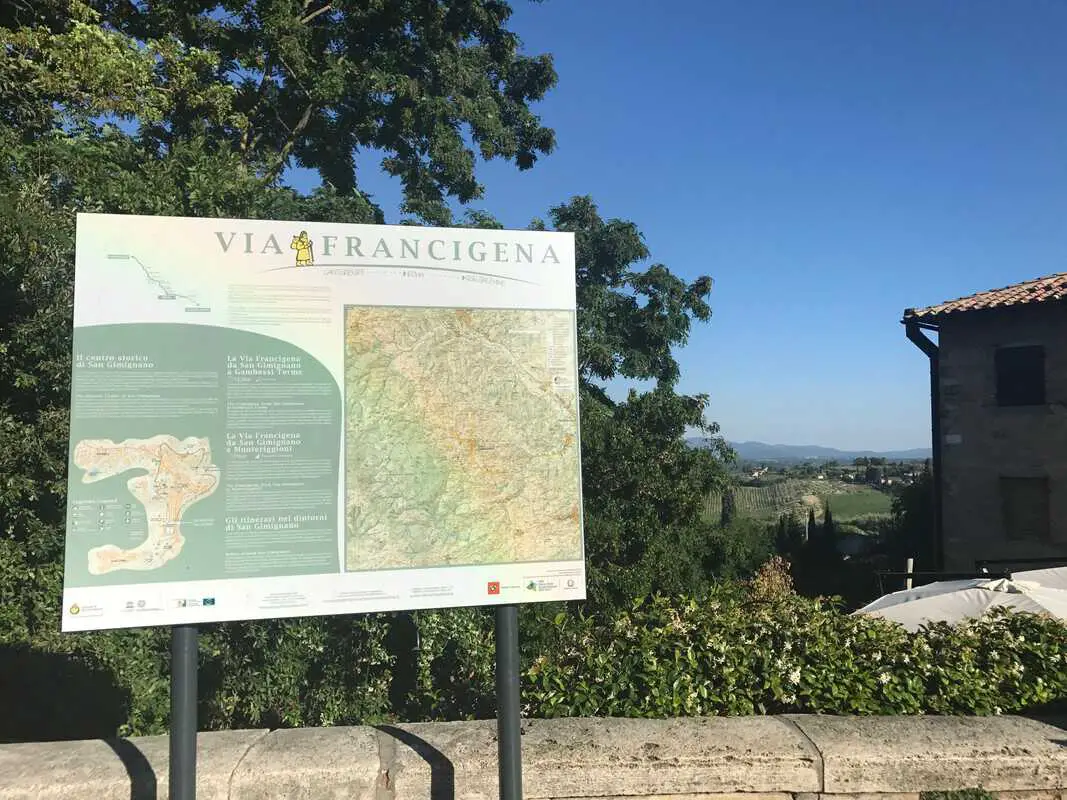
La Via Francigena is an ancient pilgrimage route that Christians, from as far as Canterbury in England, walked all the way to Rome. It happens to go through some of the most beautiful parts of Italy, including Italy’s Alps and Tuscany, and of course, ends in Rome.
In the Eternal City, La Via Francigena takes pilgrims to St. Peter’s in Vatican City along the Via Angelico to complete their journey. Those who walk at least the last 100 kilometers can receive an official Testimonium from the Vatican.
Read more:
- Every Traveler to Italy Should Know These 35 Italy Travel Tips
- How to Fly a Family of 4 to Europe on Miles
- Hacks for Getting the Most Out of European Train Travel
- 12 Firsthand Hacks to Save Money on a Trip to Paris
- European Vacation on Miles Part 4: Bologna, Italy
- European Vacation on Miles Park 5: Tuscany
- 5 of Europe’s Most Walkable Cities
- 5 Italy Travel Books to Satisfy Your Wanderlust
- Best Ways to Learn Italian in 5 Steps
Author
-

Lyn Mettler is a longtime travel writer for US News & World Report, USA Today 10Best and The TODAY Show who created Families Fly Free, a program which teaches families her simple system to use travel rewards to fly for free.

